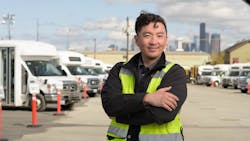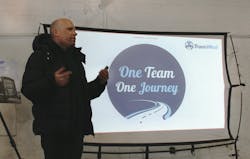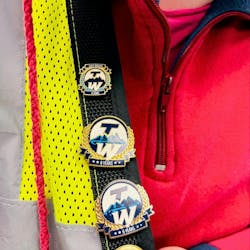An evolving safety program has proven the strength of this fleet’s safety culture
Key takeaways:
- TransWest prioritizes building an evolving safety culture through ongoing training and communication, emphasizing its responsibility in transporting people safely.
- The fleet's “Three S” approach—Safety, Service, Schedule—ensures safety is the top priority while maintaining customer service and timely arrivals.
- Utilizing telematics for tailored coaching sessions enhances driver accountability and safety, leading to over 90% of drivers qualifying for safety bonuses.
With the rise of nuclear verdicts and insurance premiums that increase each year, a fleet must ensure driver safety. But that’s easier said than done.
The safest fleets not only adhere to safety practices but also tout a safety culture. Safety cultures must be built.
TransWest, a fleet based in Washington, began its business with safety at the forefront. Twelve years later, the fleet has turned its 10-step safety program into an evolving safety culture that changes with its workforce.
“Growing a safety culture here has been a really amazing experience,” Kim Corona, director of training, safety, and compliance at TransWest, told FleetOwner. “I think the more people we get and the more people we get to train safely on the roads, [the better for] everybody in the community.”
See also: Culture is critical to improving driver safety
Service culture
TransWest’s founder and CEO, Andrew Janison, has always had an entrepreneurial spirit, but it was his mother and aunt—who both worked at international department store Nordstrom—that instilled in him that customer service is everything. He jokingly said that it was because of this “brainwashing of customer service” that he and his employees wore uniforms when he built his first business, a car-detailing company.
“They were trained with just taking good care of the clients,” Janison said. “That's not something you'd really expect in an auto detailer.”
Eventually, Janison’s auto detailing business shifted to a valet business, which then became a people-moving business. Today, TransWest moves construction and big tech employees from parking lots to worksites or across large technology campuses. The fleet occasionally transports specialized cargo between the facilities of its customers.
The fleet now operates 145 motorcoaches, 246 shuttle buses, 82 vans, and 56 sedans over three depots.
A big part of TransWest’s customer service is safety, especially considering that TransWest is a people-moving business.
“One of the things that we've trained on and we teach is that we are driving the most precious commodity you ever can drive—we're driving people,” Corona said.
While safety has always been at the forefront of leaders’ minds at TransWest, building a safety program takes time.
TransWest’s safety program evolution
Corona first came on board with TransWest as a driver. Her personality and skills led TransWest to eventually promote her to her current role as director of training, safety, and compliance. It was during her early days that TransWest used a 10-step safety training program based on the Smith System. Trainers also emphasized the two keys to safe driving: space and visibility.
As time progressed, so did the safety program.
See also: Thorough safety and training sets Reliance up for private fleet success
TransWest also now teaches its own “Three S” method, which emphasizes the importance of safety, service, and schedule. It teaches the Three S’s “in that order because we feel like safety is number one,” Corona said. Second is customer service because that “is extremely important to TransWest,” and schedule is third.
“You would think most companies would be like, ‘no, get there on time,’ but we want people to get there safely, and we want to treat them right,” Corona explained. “That's why we do the Three S’s in that order.”
TransWest also now uses telematics footage to conduct regular safety huddles with its drivers, where trainers and leaders will chat with the driver about any trending behaviors, such as harsh braking, as well as to reiterate the 10 steps of safety or answer any driver questions.
In addition to regular driver huddles, TransWest conducts driver coaching sessions once a month. These training sessions incorporate camera footage from TransWest’s telematics provider, Samsara.
“We go through the videos, and we talk about anything, like alerts: speeding alerts, crashes, harsh breaks, harsh turns,” Corona said. The supervisors sit down with the drivers and review footage to understand context. These meetings are directly tied to drivers’ safety bonuses, which are given out once a quarter.
What’s more, more than 90% of TransWest’s drivers have qualified for the safety bonus since the company launched its safety bonus program.
The one-on-one time that drivers have with coaches also allows coaches and trainers to tailor their coaching to the driver and their method of learning, as “everyone learns differently,” Corona said.
Along with different learning styles, even those that learn similarly get desensitized by hearing the same message over and over. For those instances, Corona said TransWest periodically adds and removes aspects to and from its training. Examples are seasonal training, such as winter driving, and trending alerts, such as following too closely.
Corona and her trainers will also have annual or biannual ride-alongs with their drivers. It’s these experiences that open opportunities for drivers to improve even more—something Corona said they appreciate.
Drivers “appreciate being held accountable,” Corona said. “The coaching and the way that my team goes about training people is ... to be their cheerleader; it's to help them to get better and to learn.”
As TransWest has grown and perfected its safety program, it has also recently implemented a Drive to Zero program, aimed at having no recordable accidents for a full 365 days.
“The Drive to Zero campaign has been really good ... because it's not just our company, it's everyone we touch and every person we take anywhere we go,” Corona said. “It's been a huge benefit for safety and a good campaign.”
Overall, since 2021, TransWest has only experienced one Department of Transportation-reportable accident and continues to hold a “Satisfactory” rating from the Federal Motor Carrier Safety Administration.
See also: Using safety technology to achieve operational excellence
Impact of safety on customers, community, and employees
Keeping safety at the forefront of drivers’ minds is not only a policy that benefits TransWest and its drivers but also benefits TransWest’s customers and the motoring public. With each accident a TransWest driver avoids, fewer motorists are affected by a traffic delay, or even worse, are involved in an accident.
Preventing accidents also keeps TransWest drivers on time for their customers, contributing to reliability. TransWest’s focus on safety has also led the leadership team to trial different technology solutions that increase safety. Many times, these solutions have additional benefits, such as operational efficiency planning, which helps improve TransWest's overall customer service.
“Clients don't see most of that,” Janison said. “They appreciate the product that we're providing them, but they don't realize how hard we push on the backend with technology.”
But none of that is possible without drivers who are committed to safe driving, and taking care of its drivers and its employees comes naturally to the leadership at TransWest, Janison said.
“We're a transportation business, but we're a service business that's driven by people,” he said. “It's really critical to us that not only are our people safe but that they're taken care of and they feel welcome here.”
Part of taking care of employees and offering a welcoming environment includes TransWest's commitment to safety, safety bonuses, and open-door policies. It also includes growth opportunities, of which Corona is a perfect example.
Corona started driving with TransWest as part of a summer job 11 years ago. Within 30 days, TransWest asked her to become a site manager. Since then, she’s been promoted several times.
“Most of our senior operations leaders have been promoted from within,” Janison said. In fact, nearly 100% of TransWest’s senior leaders were promoted from within until the company experienced rapid growth and needed to hire for specific tasks.
These benefits have led to increased employee retention. Janison said TransWest’s employees are hired on and then stay for quite a while.
About the Author
Jade Brasher
Senior Editor Jade Brasher has covered vocational trucking and fleets since 2018. A graduate of The University of Alabama with a degree in journalism, Jade enjoys telling stories about the people behind the wheel and the intricate processes of the ever-evolving trucking industry.




